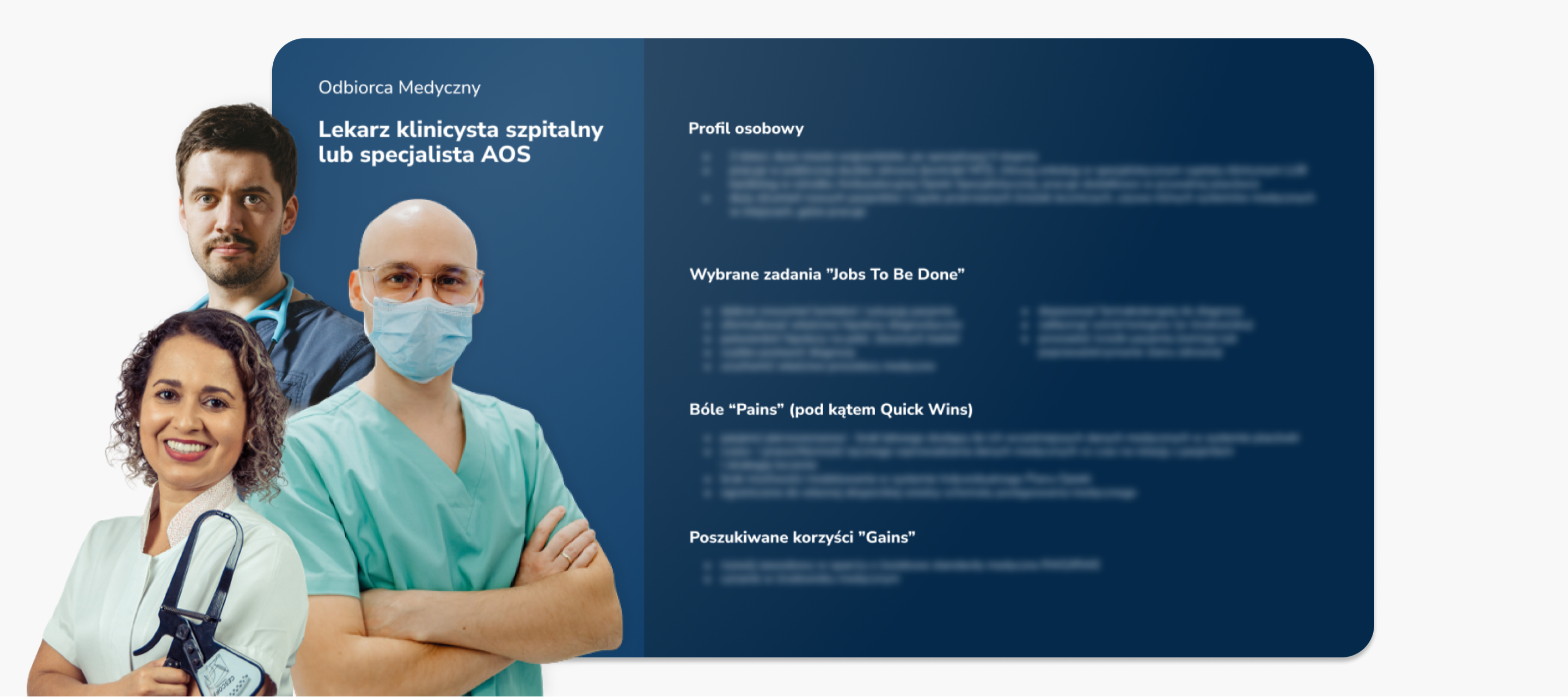Barriers and opportunities in the use of medical data
Executive summary
Challenge
- The structure and weak quality of medical data hinder optimal patient care and the execution of research projects
- It is necessary to identify barriers and opportunities and collaborate with the medical community to develop concepts for necessary changes
Actions
- Interviews with doctors, medical facility managers, researchers.
- Analysis of best practices, systemic and legislative actions.
- Building a map of key opportunities and barriers, Medical Personas profiles.
- Two-day Design Thinking co-creation workshops with medical experts, along with their summary.
Results
- Strong engagement of distinguished representatives from the medical community.
- Inspiring vision for the future in 2033.
- Over 50 jointly created and prioritized ideas.
- 10 'Quick Wins' concepts for implementation in medical facilities, as well as 'Big Wins' recommendations for systemic changes.
Service description
The Design Thinking approach and process enable understanding of problems and needs of key stakeholders, as well as the creation of project challenges where interdisciplinary teams collectively generate solution ideas. They then develop concepts for initiatives with the highest potential and optimize them using market knowledge.
Our client
EIT Health was our partner, a network of leading innovators in the field of health, comprising approximately 130 partners and supported by the European Institute of Innovation and Technology (EIT), an organ of the European Union.
It brings together key healthcare entities from across Europe to foster innovation at the intersection of science, education, and business, benefiting citizens.

Key actions
We conducted 15 in-depth interviews with representatives from the medical field and analyzed actions and plans for changes in the healthcare system.
As a result, we created a comprehensive map of barriers and opportunities, and developed insights for “Quick Wins” and “Big Wins”.
Additionally, we prepared Person profiles for three key Medical Stakeholders: doctors, facility managers, and researchers, taking into account their key challenges.
Subsequently, following the Design Thinking methodology, we facilitated a two-day co-creative workshop with 18 distinguished medical experts.
Together, we crafted a vision for the future and generated ideas and recommendations for specific actions at the medical facility level and systemic changes.
Challenge
In Poland, doctors have limited access to high-quality, well-structured medical data of patients gathered in various IT systems across multiple facilities.
As a result, the implementation of an optimal treatment pathway becomes challenging and time-consuming.
Additionally, distinguished medical researchers lack proper access to extensive databases, hindering the effective execution of advanced research and development projects.
Various factors, such as legal, IT, habitual, substantive, and educational barriers, contribute to this situation. The project involved mapping these barriers and identifying opportunities for overcoming them.
Our goals
Our task was to develop a map of barriers and opportunities, and then collectively develop with prominent representatives of the medical community:
1. Ideas for “Quick Wins” in managing medical data for direct implementation in medical facilities;
2. Directional recommendations for “Big Wins” for representatives of institutions responsible for shaping and operating the healthcare system in Poland.

Results
The map of barriers and opportunities encompassed 6 key areas and included over 80 inspirations for “Quick & Big Wins”.
The supplemented profiles of the 3 Medical Stakeholders captured their key issues, needs, and professional challenges.
During the co-creative workshops, more than 50 ideas and 10 selected concepts for “Quick Wins” and recommendations for “Big Wins” in systemic changes were generated.
Participants provided suggestions for further actions in the subsequent workshops and expressed their willingness to be involved.
We also received highly positive feedback regarding the applied process and its outcomes.
The results of our collaborative work were documented in a 35-page summary along with recommendations for the next steps.
Client benefits
The created map of barriers and opportunities provided a comprehensive overview of the challenges that need to be overcome to improve the quality of medical processes and undertake advanced research projects.
Our client and strategic partners have garnered strong support and engagement from the medical community, including distinguished representatives from leading medical and research institutions.
The concepts developed by them serve as a foundation for further collaborative work, which will focus on recommendations for necessary changes in the Polish healthcare system and the development of modern medical technologies.
Innovatika team demonstrated excellent application of inspiring Design Thinking approach. Medical experts exhibited tremendous commitment in creating valuable ideas and recommending systemic changes. Highly recommended.
Summary
For 18 years, we have been successfully utilizing the Design Thinking methodology, engaging and inspiring interdisciplinary teams in a workshop-based co-creation process of innovation.
Particularly challenging systemic problems require a comprehensive approach that considers both market and analytical aspects, while emphasizing creativity and involving key stakeholders.
Clear identification of barriers, opportunities, and market recipients’ needs allows us to determine the most important challenges to overcome.
Through collaborative teamwork, we generate numerous ideas and concepts, followed by selecting those with the highest development potential for further market validation.
Based on this, we provide recommendations for stakeholders and institutional decision-makers.
In such projects, it is crucial to establish a motivating mission and future vision among participants, which integrates them around common goals and directs further actions.